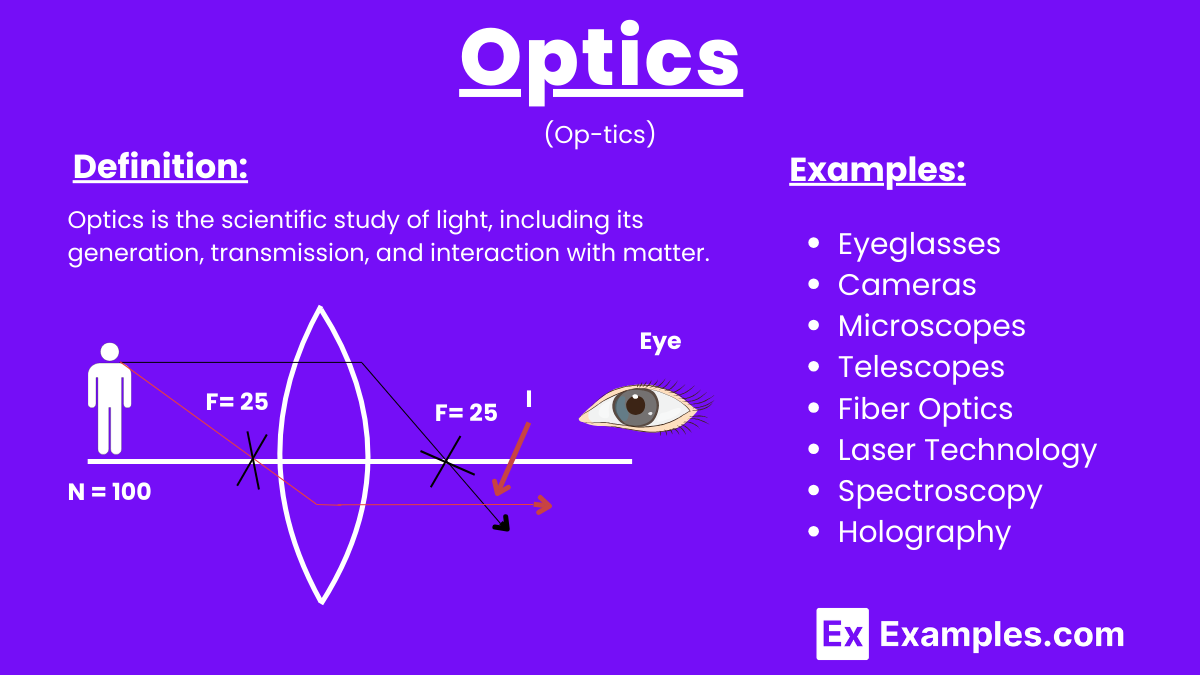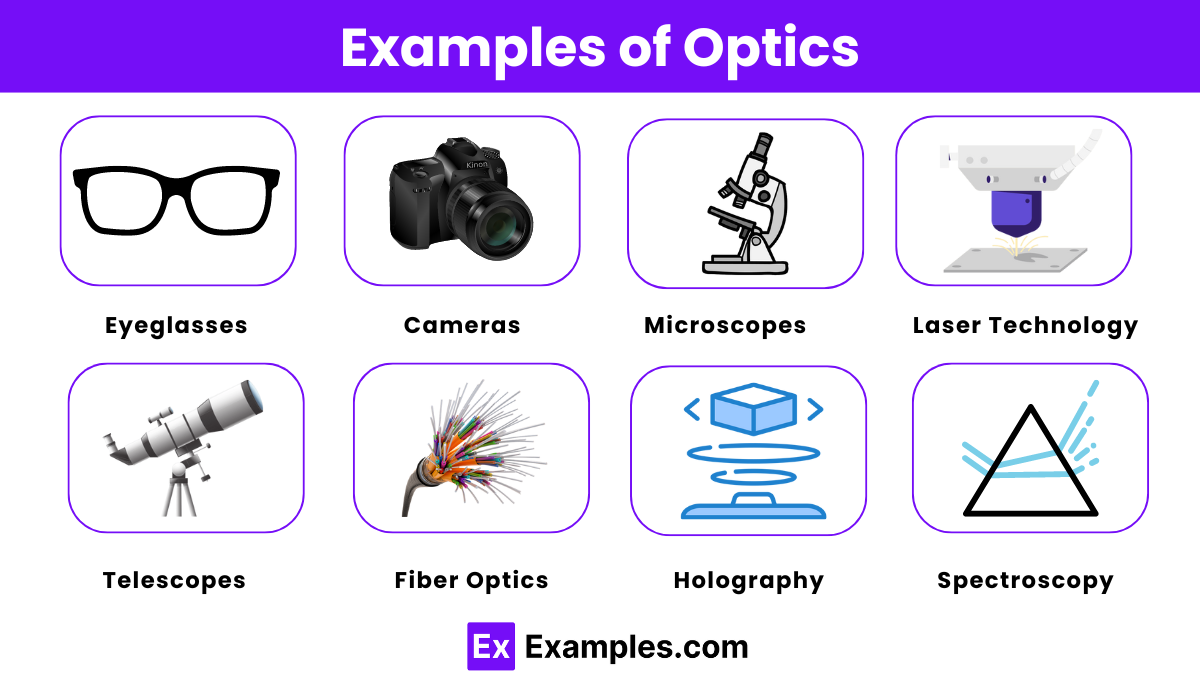What is the primary principle behind the formation of a rainbow?
Refraction
Reflection
Diffraction
Absorption


Optics is the branch of physics that studies the behavior, properties, and interactions of light, including its reflection, refraction, dispersion, and diffraction, as well as the formation of images by lenses and mirrors. This field involves the laws of wave and optics which govern these interactions and phenomena. Optics encompasses a wide range of phenomena, from the basic principles of how light travels and interacts with different materials to the complex designs of optical instruments like telescopes, microscopes, and cameras. Understanding the units of wavelength, such as nanometers and meters, is crucial in this field. Optics is essential for understanding both natural visual experiences and the development of various technologies that manipulate light for scientific, medical, and industrial applications.
Optics is the scientific study of light, including its generation, transmission, and interaction with matter. It encompasses the behavior, properties, and phenomena of light, including its interactions with lenses, mirrors, and other optical devices. Optics is fundamental to various technological applications such as cameras, eyeglasses, microscopes, and telescopes.

Eyeglasses are a common application of optics used to correct vision. Lenses in eyeglasses are designed to refract light rays in such a way that they focus correctly on the retina, improving vision clarity for those with nearsightedness (myopia), farsightedness (hyperopia), or astigmatism.
Cameras use a combination of lenses to focus light onto a photosensitive surface, such as film or a digital sensor. The optics involved determine the focus, aperture, and exposure, allowing the capture of clear and detailed images.
Microscopes use a series of lenses to magnify small objects that are otherwise invisible to the naked eye. By manipulating light through various optical components, microscopes can achieve high levels of magnification and resolution, which are essential in fields like biology and materials science.
Telescopes gather and magnify light from distant objects in the universe, such as stars and galaxies. There are two main types: refracting telescopes, which use lenses to bend light, and reflecting telescopes, which use mirrors to reflect and focus light.
Fiber optics involve the transmission of light through thin strands of glass or plastic fibers. This technology is widely used in telecommunications to transmit data over long distances with minimal loss. The light signals are internally reflected within the fiber, allowing for high-speed and high-capacity data transmission.
Lasers produce a concentrated beam of coherent light that can be used in various applications, from cutting materials and medical surgeries to communication and entertainment (e.g., laser light shows). The precision and intensity of lasers are a direct result of advanced optical principles.
Various optical instruments, such as endoscopes and ophthalmoscopes, are used in medical diagnostics and surgeries. These instruments allow doctors to view inside the body with minimal invasiveness, utilizing the principles of optics to guide light and images.
Spectroscopy is a technique used to analyze the light spectrum emitted or absorbed by substances. It helps identify chemical compositions and properties by studying the interaction of light with matter, essential in fields like chemistry, astronomy, and environmental science.
Optical communication systems use light to transmit information over long distances through optical fibers. This technology is the backbone of the internet, enabling high-speed data transfer across continents.
Holography is a technique for creating three-dimensional images using the interference patterns of light beams from a laser. It has applications in data storage, art, and security features on credit cards and IDs.
Optics can be broadly categorized into several types based on the principles and phenomena they study. Here are the main types of optics:
Geometric optics, also known as ray optics, focuses on the propagation of light in terms of rays. This branch of optics is primarily concerned with the principles of reflection and refraction and is used to describe how light travels in straight lines.
Reflection: The bouncing back of light from a surface.
Refraction: The bending of light as it passes from one medium to another.
Lenses and Mirrors: Devices that use reflection and refraction to focus or spread light.
Physical optics deals with the wave nature of light. It explains phenomena that geometric optics cannot, such as interference, diffraction, and polarization.
Interference: The superposition of two or more light waves leading to a new wave pattern.
Diffraction: The bending and spreading of light waves around obstacles and through slits.
Polarization: The orientation of light waves in a specific direction.
Quantum optics studies the interaction of light with matter at the quantum level. It combines principles from quantum mechanics and optics to explore phenomena such as photon emission and absorption.
Photons: The basic units or quanta of light.
Quantum Entanglement: A phenomenon where particles remain connected, sharing physical properties regardless of distance.
Laser Physics: The study of how lasers produce coherent light through stimulated emission.
Fiber optics involves the transmission of light through thin, flexible fibers of glass or plastic. It is a crucial technology for modern telecommunications, allowing high-speed data transfer over long distances.
Total Internal Reflection: The principle that keeps light confined within the fiber.
Optical Signal Transmission: The process of converting electrical signals into light signals for transmission.
Nonlinear optics studies the behavior of light in nonlinear media, where the response of the material to light is not directly proportional to the light intensity. This field is important for understanding high-intensity light interactions.
Harmonic Generation: The creation of new frequencies of light.
Self-Focusing: A phenomenon where a light beam focuses itself due to nonlinear interactions.
Optical Solitons: Stable light pulses that maintain their shape while traveling through nonlinear media.
Optics plays a crucial role in various fields and has a wide range of applications. Here are some key applications of optics :
The law of reflection states that the angle of incidence is equal to the angle of reflection, and both angles lie in the same plane.
Refraction is the bending of light as it passes from one transparent medium to another, caused by a change in the speed of light in different media.
Snell’s Law relates the angles of incidence and refraction to the refractive indices of the two media, expressed as n1sinθ1=n2sinθ2.
Total internal reflection occurs when light travels from a denser to a less dense medium and the angle of incidence exceeds the critical angle, causing the light to be completely reflected.
Lenses are transparent objects with at least one curved surface that refract light rays to converge or diverge, forming images. Common types include convex and concave lenses.
The focal point is the point at which parallel rays of light converge after passing through a lens or reflecting off a mirror.
Concave lenses diverge light rays, spreading them apart, while convex lenses converge light rays to a focal point.
Diffraction is the bending of light waves around obstacles or through narrow slits, resulting in interference patterns.
Polarization is the orientation of light waves in a particular direction, often achieved by passing light through a polarizing filter.
A magnifying glass is a convex lens used to produce a magnified image of an object, making it appear larger and more detailed to the viewer.
Text prompt
Add Tone
10 Examples of Public speaking
20 Examples of Gas lighting
What is the primary principle behind the formation of a rainbow?
Refraction
Reflection
Diffraction
Absorption
What does Snell's Law describe?
The intensity of light
The speed of light in a vacuum
The relationship between the angles of incidence and refraction
The color of light
What type of lens is used to correct farsightedness?
Concave lens
Convex lens
Bifocal lens
Cylindrical lens
What phenomenon occurs when light waves encounter an obstacle or slit?
Reflection
Dispersion
Diffraction
Polarization
Which law states that the angle of incidence is equal to the angle of reflection?
Snell's Law
Brewster's Law
Huygens' Principle
Law of Reflection
What is the focal point of a lens?
The point where parallel rays of light converge
The center of the lens
The point where light is absorbed
The point where light diverges
What is the critical angle in optics?
The angle at which light is absorbed by a medium
The angle at which light is refracted
The angle of incidence that results in total internal reflection
The angle at which light travels fastest
What is the primary effect of a prism on white light?
It reflects light
It polarizes light
It disperses light into a spectrum of colors
It amplifies light
What does the term 'polarization' refer to in optics?
The splitting of light into its spectrum
The alignment of light waves in a particular direction
The change in light's speed in different media
The bending of light around objects
What is the purpose of an optical fiber?
To increase the brightness of light
To transmit light signals over long distances
To reflect light
To scatter light
Before you leave, take our quick quiz to enhance your learning!

